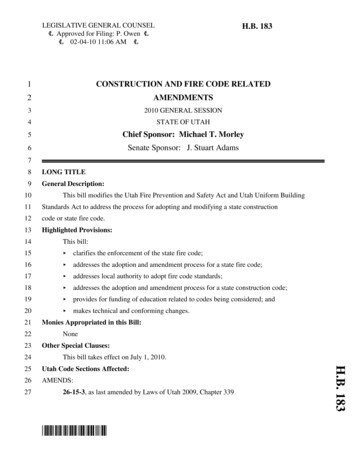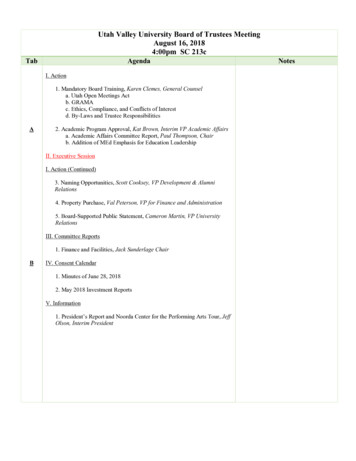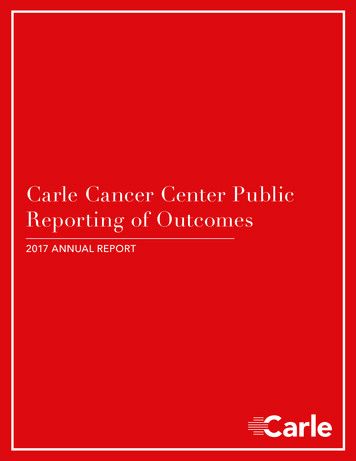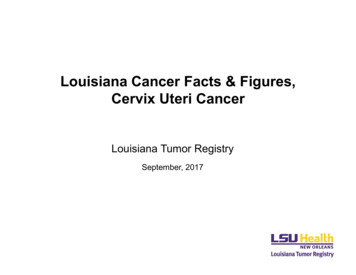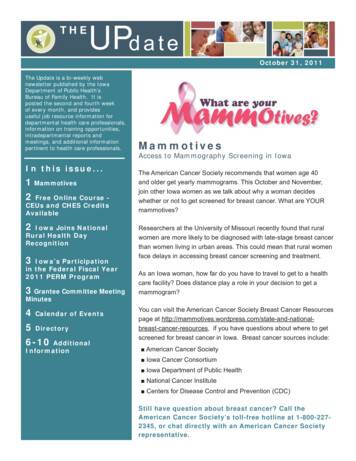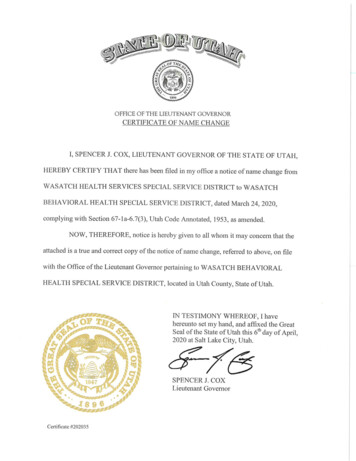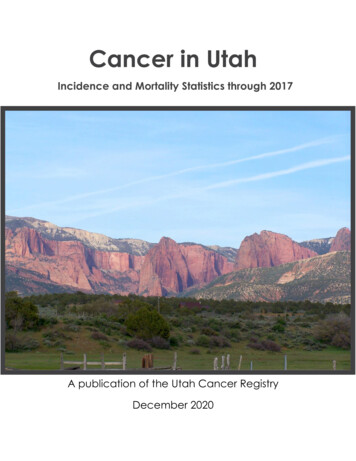
Transcription
Cancer in UtahIncidence and Mortality Statistics through 2017A publication of the Utah Cancer RegistryDecember 2020
Cancer in UtahIncidence and Mortality Statistics through 2017A publication of the Utah Cancer RegistryJennifer A. Doherty, MS, PhDExecutive DirectorPrepared byMorgan Millar, PhDKimberly Herget, MStatCarol Sweeney, PhDDecember 2020Thanks to Shantell Hicken, Valerie Yoder, BS, Mia Hashibe, PhD, and William McKean, MD, for their assistance withthe preparation of this document. Cover image courtesy of Zach Hicken.
PrefaceThis biennial report is compiled by the Utah CancerRegistry, Utah’s statewide, population-based cancerregistry, as part of its activities to disseminate cancerinformation for the state. The registry collects andmanages data used to monitor trends in cancerincidence and mortality, evaluate cancer preventionand control measures, and facilitate cancer research.Utah Cancer Registry performs this cancersurveillance function on behalf of the UtahDepartment of Health. The registry has been inexistence since 1966 and is operated by theUniversity of Utah. Cancer is a reportable disease asstated in Utah Administrative Code Rule R384-100.Reportable cases include in situ and invasiveneoplasms (with certain exceptions) as well asbenign and borderline malignant brain and othercentral nervous system tumors.Cancer surveillance in Utah is possible only with thecooperation of health care providers throughout thestate who report cancer case data. We rely on theexpertise of hospital tumor registrars who classifyand code cases for submission to the registry. Wethank these professionals for their contributions tocancer surveillance in Utah.We acknowledge the U.S. National Cancer Institute’sSurveillance, Epidemiology and End Resultsprogram (Contract No. HHSN261201800016I), theCenters for Disease Control and Prevention’sNational Program of Cancer Registries (CooperativeAgreement No. NU58DP0063200), University ofUtah Health, and the Huntsman Cancer Institute forsupport of our surveillance, public health, andresearch activities.CANCER IN UTAH I 2008-2017i
Table of ContentsPrefacePageiExecutive Summary1Chapter 1. The Burden of Cancer in Utah .1.1 Cancer diagnoses and deaths in Utah, 2017.1.2 Cancer in Utah by sex .1.3 Cancer in Utah by race and ethnicity .1.4 Cancer in Utah by geography .33568Chapter 2. Cancer in Utah Contrasted with the Remainder of the U.S. .2.1 Smoking-related cancers .2.2 Melanoma of the skin .2.3 Thyroid cancer .2.4 Tumors of the brain and nervous system .1010101213Chapter 3. Cancer Sites of Special Interest . . 3.1 Breast cancer . 3.2 Prostate cancer . .3.3 Colorectal cancer . . .3.4 Human papilloma virus (HPV)-associated cancers . .3.5 Liver cancer . . 141416171820Appendix A. Data and Methods .A.1 Compiling cancer surveillance data .A.2 Data accessed for this report .A.3 Statistical analysis .22222222Appendix B. Definitions and Abbreviations .24Appendix C. Detailed Tables of Cancer Case Counts, Incidence, and Mortality.Table C1. New cancer cases and deaths from cancer in Utah by cancer site and sex,2017 .Table C2. Cancer incidence and mortality by cancer site in Utah and the U.S., 20132017 .Table C3. 5-year relative survival in Utah, by cancer site and stage at diagnosis, 2016period .Table C4. Cancer incidence for Hispanics/Latinos and non-Hispanic whites, Utah andthe U.S. 2013-2017 .Table C5. Cancer mortality for Hispanics/Latinos and non-Hispanic whites, Utah andthe U.S. 2013-2017 .Table C6. Cancer in Utah counties: population and cancer counts, 2017 .26CANCER IN UTAH I 2008-2017272829303132
Table C7. Cancer counts and incidence in urban and rural counties in Utah, 20132017 .33References .34TablesTable 1.1 The ten most commonly diagnosed incident cancers among Utah women .Table 1.2 The ten most commonly diagnosed incident cancers among Utah men .Table 1.3 Cancer incidence by race and Hispanic/Latino ethnicity in Utah .447FiguresFigure 1.1 Numbers of new cancers and cancer deaths for common sites, Utah 2017 .Figure 1.2 Age distribution of the Utah population and cancer incidence by age,2017 .Figure 1.3 Race and Hispanic/Latino ethnicity by age in Utah, 2017 A) totalpopulation and B) incident cancer cases .Figure 1.4 Cancer sites with statistically significant differences in age-adjustedincidence or mortality between Hispanics/Latinos and non-Hispanicwhites, Utah 2013-2017 .Figure 1.5 Cancer incidence for five major sites by race and ethnicity, Utah 20132017 .Figure 1.6 Cancer sites with statistically significant differences and age-adjustedincidence or mortality by rural residence, rural compared to urbancounties, Utah 2013-2017 .Figure 2.1 Incidence and mortality for common cancers, Utah compared to the U.S.,2013-2017. Comparison of A) age-adjusted incidence of all reportabletumors and B) age-adjusted mortality .Figure 2.2 Melanoma incidence and mortality trends, Utah and the U.S., 2008-2017 .Figure 2.3 Melanoma incidence and mortality, Hispanics/Latinos compared to nonHispanic whites, Utah 2013-2017 .Figure 2.4 Melanoma incidence trends by stage at diagnosis: A) in situ, local and B)regional, distant or unstaged Utah 2008-2017 .Figure 2.5 Thyroid cancer incidence trends in Utah compared to the U.S. by sex,2008-2017 .Figure 2.6 Thyroid cancer incidence by age at diagnosis and sex, Utah 2013-2017 .Figure 2.7 Thyroid cancer incidence for non-Hispanic whites and Hispanics/Latinos,Utah and the U.S. 2013-2017 .Figure 2.8 Figure 2.8 Brain and nervous system tumor incidence and mortalitytrends in Utah and the U.S., 2008-2017 .Figure 3.1 Female breast cancer incidence and mortality trends for Utah and theU.S., 2008-2017 .Figure 3.2 Breast cancer incidence by stage at diagnosis and breast cancer mortalityfor non-Hispanic white and Hispanic/Latina women in Utah, 2013-2017 .Figure 3.3 Breast cancer incidence trends among women by stage at diagnosis: A)in situ, local, regional, and B) distant or unstaged, Utah 2008-2017 .CANCER IN UTAH I 2008-2017235678910111112121213141415
Figure 3.4 Breast cancer relative five-year survival by stage and age at diagnosis inUtah .Figure 3.5 Prostate cancer incidence and mortality trends in Utah compared to theU.S., 2008-2017 .Figure 3.6 Prostate cancer incidence trends by stage at diagnosis: A) local and B)regional, distant or unstaged, Utah 2008-2017 .Figure 3.7 Prostate cancer incidence, Hispanics/Latinos compared to non-Hispanicwhites in Utah and the U.S., 2013-2017 .Figure 3.8 Colorectal cancer incidence and mortality trends in Utah compared tothe U.S., 2008-2017 .Figure 3.9 Colorectal cancer incidence trends by stage at diagnosis, amongindividuals aged A) younger than 50 years and B) 50 years and older,Utah 2008-2017 .Figure 3.10 Five-year relative survival in Utah residents diagnosed with colorectalcancer by stage and age at diagnosis .Figure 3.11 Incidence and mortality trends for cancers associated with humanpapilloma virus (HPV), Utah and the U.S. 2008-2017 .Figure 3.12 Incidence of human papilloma virus (HPV)-associated cancers by sexand cancer site, Utah 2013-2017 .Figure 3.13 Incidence and mortality of human papilloma virus (HPV)-associatedcancers, Hispanics/Latinos compared to non-Hispanic whites, Utah2013-2017 .Figure 3.14 Hepatocellular carcinoma liver cancer incidence and liver cancermortality (all histologies) trends in Utah compared to the U.S., 20082017 .Figure 3.15 Hepatocellular carcinoma liver cancer incidence in Utah by race andethnicity, 2013-2017 .CANCER IN UTAH I 2008-2017151616171718181919192020
Executive SummaryThis report provides the most recent cancersurveillance data for the state of Utah. It describesthe number of Utahns diagnosed with cancer during2017, the number of cancer deaths in 2017, ageadjusted cancer incidence rates averaged over thefive-year period 2013-2017, and ten-year trends forcancer incidence and mortality.lung cancer and a number of other smoking-relatedcancers. However, Utah has higher incidence ofcertain cancers compared to the remainder of theU.S., notably melanoma of the skin. Utah’s melanomaincidence increased significantly during the period2010 through 2017. Utah's melanoma mortalityexceeds that of the remainder of the U.S.In 2017, 13,604 new cancers were diagnosed in Utah.The most commonly diagnosed cancer among Utahwomen was breast cancer, while prostate cancer wasthe most frequently diagnosed cancer among men(Chapter 1). Melanoma of the skin was the secondmost common cancer site for both men and women.The overall incidence of cancer amongHispanic/Latino Utahns is lower than the incidencefor non-Hispanic white Utah residents. However,incidence of cancers of the liver, stomach, cervix, andkidney and renal pelvis are higher amongHispanic/Latino Utahns than non-Hispanic whites.Black residents have higher incidence of prostatecancer than other racial groups in Utah, andincidence of breast cancer is lower among AmericanIndians and Alaska natives. For most cancer sites,incidence in rural Utah counties is similar toincidence in urban counties. Cancer sites with higherincidence among rural Utah residents include lungcancer and leukemia.This report summarizes incidence and mortality forbreast, prostate, colorectal, and HPV-associatedcancers, which account for a large part of the state'scancer burden (Chapter 3). Utah’s breast cancerincidence is lower than the remainder of the U.S.Non-Hispanic white women in Utah have higherbreast cancer incidence and mortality thanHispanic/Latina women. Changing trends in theutilization of prostate-specific antigen (PSA)screening have resulted in declining prostate cancerincidence in the U.S. and Utah, particularly for earlystage diagnoses. A majority of prostate cancerdiagnoses are made at the local or regional stage.However, incidence of distant stage prostate cancerhas increased in Utah over the ten-year period 20082017. Colorectal cancer incidence has declined overseveral decades with the widespread use ofscreening, and both colorectal cancer incidence andmortality trended significantly downward over theperiod 2008-2017. However, colorectal cancerincidence among Utahns aged under 50 increasedsomewhat from 2008 through 2017.In 2017, 3,160 Utahns died from cancer, making itthe second largest cause of death after heart disease.Lung cancer was the leading cause of cancer death,followed by breast and colorectal cancers.Individuals diagnosed with cancer at early stages canexpect survival that is similar to those free of cancer,and there were 113,722 cancer survivors in Utah in2017.A number of cancer sites exhibit lower incidence andmortality in Utah compared to the remainder of theUnited States (U.S.) (Chapter 2). The proportion ofUtah residents who smoke cigarettes has for manyyears been lower than in other areas of the country,contributing to lower incidence and mortality fromCANCER IN UTAH I 2008-2017In conclusion, cancer continues to significantlyimpact the health of Utahns. Because of Utah'shistorically low prevalence of cigarette smoking, theburden of cancer is somewhat less than in other U.S.states. Variation in incidence of certain cancer sitesis apparent across different race/ethnic groups andrural compared to urban locations in Utah. WithUtah's high incidence of melanoma, public healthmessages about sun protection and melanomaawareness are important. The impact of cancercontrol efforts is evident in the trend of decliningmortality from colorectal cancer.1
Figure 1.1 Numbers of new cancers and cancer deaths for common sites, Utah 20172
Chapter 1. The Burden of Cancer in Utah1.1 Cancer diagnoses and deaths in Utah, 2017In 2017, 13,604 new cancers were diagnosed amongUtah residents. Of these, 10,942 were invasivecancers and 2,662 were in situ or benign. The cancersite with the largest number of new invasive cases in2017 was breast cancer. The other most commonlydiagnosed invasive cancers included prostatecancer, melanoma of the skin, colorectal cancer, andlung cancer (Figure 1.1 and Appendix C1). In situtumors, which are non-invasive and therefore moreeasily treated, were frequent for melanoma,accounting for over half of the in situ diagnoses, andbreast cancer. Tumors that are classified as benignare not reportable to the cancer registry unless theyoccur in the brain or elsewhere in the centralnervous system. In 2017, 732 benign brain andnervous system cases were diagnosed in Utah. Dataprovided throughout this report include allreportable tumors, i.e. invasive, in situ, and benignbrain and central nervous system, except whenotherwise noted.In 2017, 3,160 Utahns died due to cancer. Cancer isthe second most common cause of death in Utah,after heart disease,1 accounting for 17.5% of alldeaths in the state.2 The leading causes of cancerdeath were lung cancer, breast cancer, colorectalcancer, and pancreatic cancer (Figure 1.1 andAppendix C1). Cancer survival varies considerablyby cancer site and is highly dependent upon thestage at which the cancer is diagnosed (AppendixC3). Those diagnosed with cancer at in situ and localstages had overall 95.8% five-year survival relativeto comparable-age individuals. On January 1, 2017,there were an estimated 113,722 cancer survivors inthe state of Utah. These survivors represented 3.7%of the state’s population. There were over 22,000breast cancer survivors, over 21,000 prostate cancersurvivors, and over 17,000 melanoma survivors.The median age of Utahns in 2017 was 30.9 years,which is younger than in any other state in the U.S.3Cancer incidence is highly related to age, withdiagnoses being much less frequent among children,adolescents, and young adults than in the olderpopulation (Figure 1.2). Utah’s relatively youngpopulation means that a smaller proportion ofindividuals are in the older age groups in whichcancer diagnoses are more common. In 2017 therewere 256 incident cancers among the over 1 millionUtahns younger than 20 years of age. Thus residentsaged less than 20 years, who represent nearly 33%of Utahns, experience fewer than 2% of cancerdiagnoses. Conversely, residents aged 60 and older,who represent only 15% of the Utah population,account for nearly 63% of cancer diagnoses.Figure 1.2 Age distribution of the Utah population and cancer incidence by age, 2017CANCER IN UTAH I 2008-20173
Table 1.1 The ten most commonly diagnosed incident cancersamong Utah women2017 casesCancer TypeBreastMelanoma of the skinBrain and nervous systemColorectalUterineThyroidLungNon-Hodgkin lymphomaLeukemiaOvaryInvasive In Situ1,58245185384373322306186173163309537482b000 10.611.32017Deaths280174612958 2014968101 Number suppressed due to small cell size.aIncidence rate per 100,000 population per year for all reportable tumors, i.e.invasive, in situ, and benign brain and nervous system. Age-adjusted, for fiveyears 2013-2017.bIncludes benign brain and nervous system tumors.Table 1.2 The ten most commonly diagnosed incident cancersamong Utah men2017 casesCancer TypeProstateMelanoma of the skinColorectalBladderBrain and nervous systemLungNon-Hodgkin lymphomaKidneyLeukemiaPancreasInvasive In .512.52017Deaths212511436380250834792141aIncidence rate per 100,000 population per year for all reportable tumors, i.e.invasive, in situ, and benign brain and nervous system. Age-adjusted, for fiveyears 2013-2017.bIncludes benign brain and nervous system tumors.CANCER IN UTAH I 2008-20174
1.2 Cancer in Utah by sexThe most commonly diagnosed cancer sites varyaccording to sex. In 2017, there were 6,700 cancerdiagnoses in Utah women (Appendix C1). Amongwomen in Utah, breast cancer was the mostcommonly diagnosed cancer, with 1,582 invasivediagnoses and 309 in situ diagnoses, and ageadjusted incidence of 137.0 per 100,000 per year(Table 1.1). Breast cancer comprised 28.2% of alldiagnoses among Utah women in 2017. Melanoma ofthe skin, including 451 invasive and 537 in situ cases,was the second most common cancer diagnosisamong women, with age-adjusted incidence of 59.6per 100,000 per year. The next most commonlydiagnosed cancers among Utah women were brainand nervous system, the majority of which werebenign, followed by colorectal cancers.In 2017, 1,478 Utah women died of cancer. Therewere 280 deaths due to breast cancer, representing18.9% of all cancer deaths among Utah women. Lungcancer and colorectal cancer were the second andthird most common causes of cancer deaths amongwomen, accounting for 13.6% and 8.7% of cancerdeaths, respectively. Although melanoma diagnoseswere common among Utah women, there were only17 deaths from melanoma in 2017.Among Utah men, there were 6,904 cancer diagnosesin 2017. Prostate cancer was the most frequentlydiagnosed cancer for men, with 1,525 cases and anage-adjusted incidence rate of 112.8 cases per100,000 per year (Table 1.2). Prostate cancerdiagnoses accounted for 22.1% of cancer diagnosesamong Utah men in 2017. The second mostcommonly diagnosed cancer among men wasmelanoma, with 616 invasive and 764 in situ cases,and an age-adjusted incidence rate of 98.6 cases per100,000 per year. The third most commonlydiagnosed cancer among Utah men was colorectalcancer.In 2017, 1,682 Utah men died from cancer. Whilelung cancer was only the fifth most commonlydiagnosed cancer among men in Utah, it was theleading cause of cancer death among Utah men,accounting for 14.9% of cancer deaths. The secondmost common cause of cancer death among Utahmen was prostate cancer, representing 12.6% ofcancer deaths. Colorectal cancer had the third largestnumber of deaths among men in the state,accounting for 8.5% of cancer deaths.Numbers of cancer diagnoses and deaths amongUtah men and women for other sites are provided inFigure 1.3 Race and Hispanic/Latino ethnicity by age in Utah, 2017 A) total population and B)incident cancer casesCANCER IN UTAH I 2008-20175
Appendix C1, and incidence and mortality rates bycancer site are in Appendix C2.1.3 Cancer in Utah by race and ethnicityA majority of Utah residents are non-Hispanicwhites, who were 80.0% of Utah’s 2017 population4(Figure 1.3 A). Utah’s Hispanic/Latino populationhas been growing rapidly and Hispanics/Latinos ofany race comprised 14.0% of Utah’s 2017population. The next largest group in Utah is theAsian and Pacific Islander population, 3.8% ofUtahns. Black or African American residents makeup 1.4% of the population and American Indian andAlaska Natives represent 0.6%.The Utah Hispanic/Latino population is youngerthan the non-Hispanic white population,representing 17.6% of the population younger thanage 20 years but only 6.2% of the population ages 60and older (Figure 1.3 A). With relatively fewHispanics/Latinos in the older age groups that havehigh cancer incidence rates, only 7.0% of newcancers in the state were diagnosed amongHispanics/Latinos. Hispanics/Latinos account for18.8% of incident cancer cases aged 19 and younger,but only 5.3% of cases aged 60 and older (Figure 1.3B). Even when the difference in age distribution istaken into account, Hispanics/Latinos in Utah havelower cancer incidence than non-Hispanic whites;the 2013-2017 age-adjusted cancer incidence rate of425.7 per 100,000 per year among UtahHispanics/Latinos was statistically significantlylower than the incidence for Utah non-Hispanicwhites (Table 1.3 and Appendix C4). Age-adjustedcancer mortality, 109.1 deaths per 100,000 per yearamong Hispanics/Latinos, is also statisticallysignificantly lower than the 126.8 per 100,000 peryear observed among non-Hispanic whites(Appendix C5).Figure 1.4 Cancer sites with statistically significant differences in age-adjusted incidence ormortality between Hispanics/Latinos and non-Hispanic whites, Utah 2013-2017. Positive percentdifference indicates rate higher among Hispanics/Latinos compared to non-Hispanic whites. Negativepercent difference indicates lower rate among Hispanics/Latinos.CANCER IN UTAH I 2008-20176
Table 1.3 Cancer incidence by race andHispanic/Latino ethnicity in UtahRace and ethnicity2017 IncidenceCasesrateaWhite, non-HispanicHispanic/LatinoBlack or African AmericanAsian or Pacific IslanderAmerican Indian or 293.4Incidence per 100,000 per year for the period 2013-2017.When cancer for specific sites is compared betweenHispanics/Latinos and non-Hispanic whites in Utah,several differences are noted. Cancer sites withstatistically significant differences in incidence ormortality between Utah Hispanics/Latinos and nonHispanic whites are shown in Figure 1.4.Hispanics/Latinos had significantly lower ageadjusted incidence rates for melanoma, urinarybladder, brain and nervous system, and prostatecancers. Conversely, the 2013 through 2017incidence rates for liver, stomach, cervical, andkidney and renal pelvis cancers were statisticallysignificantly higher among Hispanics/Latinoscompared to non-Hispanic whites. Mortality ratesfor liver and stomach cancers were also higheramong Hispanics/Latinos. Higher incidence ofstomach, cervical, and liver cancers amongHispanics/Latinos compared to non-Hispanic whitesis consistent with a pattern reported throughout theU.S.5 Hepatitis C infection, which is known to havehigh prevalence among Hispanic/Latino immigrants,is thought to contribute to the higher liver cancerincidence among Hispanics/Latinos.6 Higherstomach cancer incidence in Hispanics/Latinos hasbeen suggested to be related to higher prevalence ofH. pylori infection and differences in diet.5,7 Humanpapilloma virus (HPV), an important factorinfluencing cervical cancer incidence, is discussed inChapter 3.4. Incidence and mortality rates by cancersite for Hispanics/Latinos in Utah are shown in detailin Appendix C4 and Appendix C5.Utah's residents who are black or African Americanare another population with an age distribution thatis markedly young compared to the state's majoritynon-Hispanic whites. In contrast to the populationaged 0 to 19 years, among whom 1.8% are black,only 0.6% of Utah residents who are ages 60 yearsand older are black (Figure 1.3 A). Because there arerelatively few black individuals in the older agegroups that have high cancer incidence, there wereonly 100 incident cancers reported in black Utahnsin 2017 (Table 1.3).Figure 1.5 Cancer incidence for five major sites by race and ethnicity, Utah 2013-2017CANCER IN UTAH I 2008-20177
The age-adjusted cancer incidence rate of 474.7 per non-white races is so small that it is not feasible to100,000 for black Utahns in 2013-2017 did not interpret differences across racial groups in Utah.significantly differ from the rate for non-Hispanic1.4 Cancer in Utah by geographywhites. Cancer incidence among Utah Asian andPacific Islanders was statistically significantly lower Utah is a geographically large state of 84,899 squarethan for non-Hispanic whites. The race group with miles. Roughly 85% of the state’s population of overthe lowest overall cancer incidence were Utah 3.1 million lives in six urban counties along theresidents who were American Indian or Alaska Wasatch Front. Population size and cancer incidencenatives. American Indians in the U.S. Southwest for rural and urban counties are shown in Appendixregion, including Utah, have been reported to have C6 and C7. Variation in cancer incidence andsignificantly lower incidence of cancer overall and mortality between metropolitan and nonlower incidence of breast, prostate, and lung metropolitan areas in the U.S. and in Utah has beendescribed.10,11 The age-adjusted incidence rates forcancers8,9 compared to non-Hispanic whites.all cancer sites combined from 2013 through 2017 inComparing cancers with high incidence in the state urban counties was 488.6 per 100,000 per year,by race (Figure 1.5), a high incidence of prostate somewhat higher than the incidence of 476.0 percancer among black individuals and a low incidence 100,000 for rural counties. Cancers with statisticallyof breast cancer among American Indians or Alaska significant differences in age-adjusted incidence orNative individuals are apparent. Incidence of mortality between rural and urban counties aremelanoma of the skin is low in all other groups shown in Figure 1.6. The cancer sites that exhibitedrelative to non-Hispanic whites. Because of the small the strongest contrast of higher age-adjustednumber of annual incident cancers among the non- incidence in rural counties compared to urbanwhite race groups in Utah, the estimates of incidence counties were lung cancer and leukemia. Thefor each of these five cancer sites are imprecise, as cancers with higher incidence rates in urbanindicated by the wide 95% confidence intervals in counties compared to rural counties include brainFigure 1.5. For cancers of other sites with even lower and nervous system tumors, uterine cancer, breastin
Registry, Utah's statewide, population-based cancer registry, as part of its activities to disseminate cancer information for the state. The registry collects and manages data used to monitor trends in cancer incidence and mortality, evaluate cancer prevention and control measures, and facilitate cancer research. .
